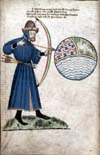| Introduction |
International
John Gower
Society
|
"John Gower’s Transformation of the Tale of Constance from Nicholas Trevet’s Of the Noble Lady Constance" Table of Contents Introduction: Peter G. Beidler My dozen students and I are pleased to offer this web publication of a comparison of John Gower’s Tale of Constance in the Confessio Amantis (written in the early 1390s) with its immediate source in Nicholas Trevet’s Of the Noble Lady Constance in his Anglo-Norman Chronicles (written in the early 1330s). This work resulted from my fall 2005 graduate seminar at Lehigh University. At the start of the seminar I divided the story of Constance into thirteen narrative units and assigned one to each of my students and myself. The only exception was that one of the students, Samuel Norwood, had a split assignment—that is, two shorter narrative units, numbered here as 7, dealing with Allee, the king of Northumberland. The day we discussed the thirteen units in class I presented my students with a draft of a paper I had written on my unit, number 10, “The Attempted Rape.” That unit deals with the incident in which a renegade Christian from the coast of Spain comes aboard Constance’s drifting boat and attempts to seduce her. I had found some interesting changes that Gower made. For example, while in Trevet, Constance herself had pushed the would-be rapist overboard, in Gower, Constance prays to God for help, and God then pushes the rapist overboard. In my essay I noted such alterations and wrote about why Gower made the changes he made. I encouraged my students to use my essay as a general model for essays they were to write on the narrative units assigned to them. I suggested some general guidelines about how they would set up their own essays. Since most readers do not know well either Trevet’s story or Gower’s, it would be good, I said, to begin each paper with brief summaries of the plots of their portions of the two versions, and then immediately summarize their own main conclusions about Gower’s changes. Although our work does not discuss Chaucer’s Man of Law’s Tale, we felt sure that our essays would be of help to anyone working on the probable antecedents of Chaucer’s story of Constance, so we would give in the table of contents parenthetical references to the corresponding lines in the Man of Law’s Tale. We would generally quote from Trevet in the Old French of Correale’s edition, but also cite Correale’s excellent English translation. The line references would be to the French version. We would use Correale’s spelling of the names when referring to the various characters (Alla, Maurice, Telous, Tiberius, Olda, Hermegild) from the Anglo-Norman text, but use Gower’s spelling (Allee, Moris, Theloüs, Tiberie, Elda, Hermyngheld) when referring to the English ones. We would, for the most part, write only about our own sections of the narrative, but would if it seemed advisable refer in passing to relevant passages in a narrative unit assigned to someone else. Although we all worked independently, we have together compiled a list of collective conclusions about the general direction of Gower’s adaptations of the raw materials he found in Trevet. The main events of Gower’s version of the story track almost perfectly with Trevet’s, but Gower’s version is quite different:
The detractor is like the nettle that crowds out the lovely red rose and makes it fade and grow pale:
Even more graphically, the detractor is like the “scharnebude” or dung beetle that on a spring day in May ignores the lovely flowers and flies straight for a feast of animal excrement:
Gower, through Genius, is clearly here setting up the Tale of Constance as a story about envy in general and about bottom-feeding dung-beetle detractors in particular—people like Domilde who refuse to acknowledge the moral beauty of the lovely flower Constance and try to make her appear ugly by spreading slanderous words about her. Those are our collective conclusions. The authors of the individual pieces below have more to say about particular discoveries they have made. I should point out that, though we have all in some ways profited from the ideas and suggestions of others in our seminar, each of us has worked for the most part independently and is fully responsible for both the virtues and the flaws of her or his own narrative unit. As is too usual with Gower studies, little of substance has been done for us to build on in comparing the work of Trevet and Gower. Typically scholars are far more interested in what Chaucer did with Trevet in the Man of Law’s Tale than with what Gower did with Trevet in the Tale of Constance. Still, some work has been done. G. C. Macaulay in his notes to the Early English Text Society edition, the four-volume The Works of John Gower (1900), has a long note on the differences between Trevet’s and Gower’s versions of the story of Constance. In volume 1 of the Oxford University Press edition of 1901, Macaulay lists some eighteen differences between the two versions (see his note to lines 587 ff., on pages 482-83). Macaulay does almost no analysis of the differences, however, except through quite general statements like “Gower has followed the original more closely than Chaucer, but he diverges from it in a good many points” (p. 482) and “These differences, besides others of detail, show that Gower treated the story with some degree of freedom” (p. 483). More recent scholars have commented in general terms on the relationship between Trevet’s and Gower’s versions. V. A. Kolve, for example, tells us that “[f]or both Trevet and Gower, these are real personages inhabiting a real past, and they confer upon the whole narrative an important kind of medieval credibility; moral meaning emerges from a historical narrative” (Chaucer and the Imagery of Narrative: The First Five Canterbury Tales [Stanford U P, 1984], p. 299). Arno Esch admires Gower’s skill at developing the parallelism embedded in Trevet’s narrative: Gower follows his source very closely. But he has not only left out superfluous passages, he has above all emphasised the parallelism in the story much more than is the case in Trivet’s version. The events of the first part, from the beginnings in Rome and the journey to Syria to the expulsion and the landing in Northumbria, appear in fuller instrumentation in the second part, which includes both the events in England and Constance’s second expulsion and rescue. The preliminary character of the first part is evident not only from the fact that it is only a third as long as the second; significantly, all of the major figures besides Constance and her parents remain nameless, while in the second part all the important characters and even many minor ones are called by name. As the proposed wedding with the Sultan stands at the center of the first section, the marriage with King Allee stands at the center of the second. The conversion of the Syrian merchants corresponds to the conversion of Hermyngheld and Elda; the message of the merchants to the Sultan to that of Elda to Allee; the conversion of the Sultan to that of the Northumbrian king. The mothers of the Sultan and Allee are the evil intriguers. Twice Constance is exiled, twice she wanders for years upon the sea, and twice she is kindly sheltered. Through the emphasis on the parallel structure, Gower binds the different episodes together and makes the basic pattern of divine guidance transparently clear. (“John Gower’s Narrative Art,” translated from Esch’s 1968 article by Linda Barney Burke, in Peter Nicholson, ed., Gower’s Confessio Amantis: A Critical Anthology [D. S. Brewer, 1991], p. 97) Peter Nicholson tells us, more helpfully, that Gower’s tale was shorter, and clearer, and more sharply focused than Trevet’s was. Gower had eliminated most of what was extraneous in his source, and had preserved what was most apt. In cutting away, of course, he also gave shape: Gower had raised Constance above the background of the chronicle account of her life, and he raised the moral and emotional lines of the story above the elaborate account of movements and motivations in Trevet’s version; and it was he who first extracted from the mass of detail and episode in Trevet the simple tale of the trials and endurance of the long-suffering heroine and gave it the form by which we know it so well now from the Man of Law’s Tale. In doing so, he also sharpened the focus of each episode, providing in almost every case a memorable image or picture where Trevet was scattered or diffuse. (“The Man of Law’s Tale: What Chaucer Really Owed to Gower,” Chaucer Review 16 (1991): 170) Most scholars, however, rush past Gower’s version to praise what they see as the greater artistic glories of Chaucer’s version. In our analyses below we attempt to discern in more specific terms the patterns in Gower’s treatment of the story he learned from Trevet. To keep the attention clearly on Gower, we make no comparisons with Chaucer’s version of the story of Constance, since virtually all scholars agree that Gower did not know the Man of Law’s Tale (see especially Peter Nicholson, “Chaucer Borrows from Gower: The Sources of the Man of Law’s Tale” in Chaucer and Gower: Difference, Mutuality, Exchange, edited by R. F. Yeager (University of Victoria, 1991], pp. 85-99). We are grateful to Bob Correale for generously allowing us to use for our class a pre-publication copy of his facing-page translation of Trevet’s account from volume 2 of Sources and Analogues of the Canterbury Tales, edited by Robert M. Correale and Mary Hamel (D. S. Brewer, 2006), pp. 296-329. Our citations from Trevet are from that edition. Our citations from Gower are to Macaulay’s standard EETS edition, referred to above. We found helpful Russell A. Peck’s glosses in his selective edition of the Confessio Amantis (Medieval Academy of America, 1980 (for the Tale of Constance, see pp. 108-36). We are grateful to Robert F. Yeager, president of the John Gower Society, for his encouragement of this project, and to Brian Gastle, manager of the Society’s website, for his help in mounting this collection of essays. Finally, we want to thank Wendy A. Deacon for combining the various sections into one large document and for helping to prepare the final copy for this web publication. Originally
Posted: April 4, 2006
|
 |
"I throw my darts and shoot my arrows
at the world. But where there is a righteous man, no arrow strikes.
But I wound those who live wickedly. Therefore let him who recognizes
himself there look to himself." Site Hosting Provided Compliments of Western
Carolina University |
 |
